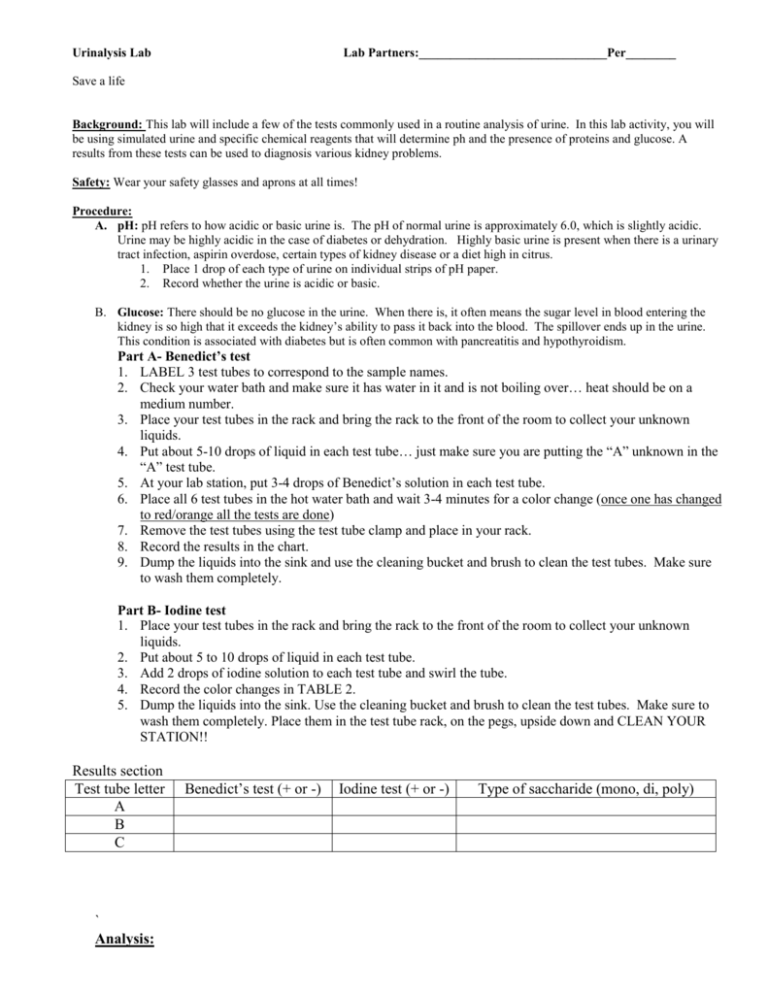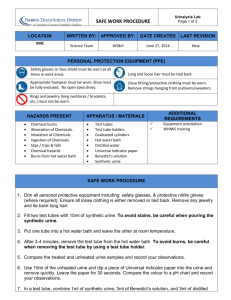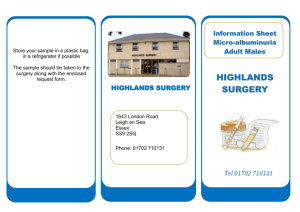Urinalysis Lab - Brookwood High School
advertisement

Urinalysis Lab Lab Partners:______________________________Per________ Save a life Background: This lab will include a few of the tests commonly used in a routine analysis of urine. In this lab activity, you will be using simulated urine and specific chemical reagents that will determine ph and the presence of proteins and glucose. A results from these tests can be used to diagnosis various kidney problems. Safety: Wear your safety glasses and aprons at all times! Procedure: A. pH: pH refers to how acidic or basic urine is. The pH of normal urine is approximately 6.0, which is slightly acidic. Urine may be highly acidic in the case of diabetes or dehydration. Highly basic urine is present when there is a urinary tract infection, aspirin overdose, certain types of kidney disease or a diet high in citrus. 1. Place 1 drop of each type of urine on individual strips of pH paper. 2. Record whether the urine is acidic or basic. B. Glucose: There should be no glucose in the urine. When there is, it often means the sugar level in blood entering the kidney is so high that it exceeds the kidney’s ability to pass it back into the blood. The spillover ends up in the urine. This condition is associated with diabetes but is often common with pancreatitis and hypothyroidism. Part A- Benedict’s test 1. LABEL 3 test tubes to correspond to the sample names. 2. Check your water bath and make sure it has water in it and is not boiling over… heat should be on a medium number. 3. Place your test tubes in the rack and bring the rack to the front of the room to collect your unknown liquids. 4. Put about 5-10 drops of liquid in each test tube… just make sure you are putting the “A” unknown in the “A” test tube. 5. At your lab station, put 3-4 drops of Benedict’s solution in each test tube. 6. Place all 6 test tubes in the hot water bath and wait 3-4 minutes for a color change (once one has changed to red/orange all the tests are done) 7. Remove the test tubes using the test tube clamp and place in your rack. 8. Record the results in the chart. 9. Dump the liquids into the sink and use the cleaning bucket and brush to clean the test tubes. Make sure to wash them completely. Part B- Iodine test 1. Place your test tubes in the rack and bring the rack to the front of the room to collect your unknown liquids. 2. Put about 5 to 10 drops of liquid in each test tube. 3. Add 2 drops of iodine solution to each test tube and swirl the tube. 4. Record the color changes in TABLE 2. 5. Dump the liquids into the sink. Use the cleaning bucket and brush to clean the test tubes. Make sure to wash them completely. Place them in the test tube rack, on the pegs, upside down and CLEAN YOUR STATION!! Results section Test tube letter A B C ` Analysis: Benedict’s test (+ or -) Iodine test (+ or -) Type of saccharide (mono, di, poly) 1. Blood contains glucose, phosphates, and chloride molecules whereas urine normally contains only phosphates and chlorides. What does this indicate about the function of the kidneys? 2. The contents of a person’s urine can change throughout the day. Explain why you think this might occur. 3. How would a positive result for each of these components in the urine look? a. glucose b. phosphates 4. Sometimes people take medicines that may change the appearance of their urine. If a person saw red to red-brown urine, what drug might be responsible? 5. Alcohol causes what change in the color of the urine? 6. What might a healthy, disease-free person have a high amount of glucose present in the urine?








